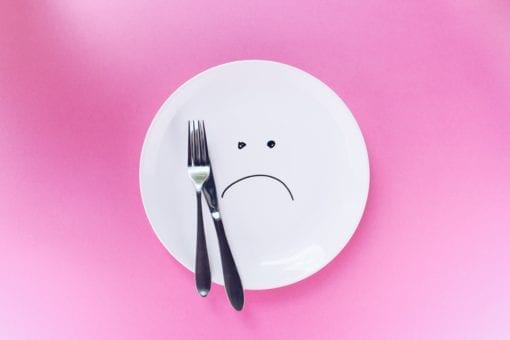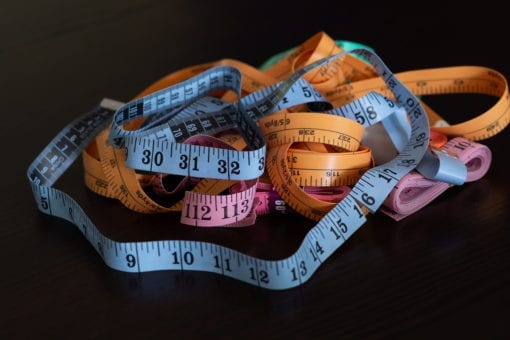Anorexia nervosa is a serious and deadly eating disorder that impacts at least 30 million people in the United States alone. But it can be a quiet disorder that slowly erodes people’s bodies, lives, relationships and well-being. In most people’s minds, and unfortunately in clinical settings, anorexia nervosa is typically characterized by low body weight. But that can leave out a lot of people who need help. So, what are the signs of anorexia? And how can we tell when someone we love may be in need of treatment?

Photo by Thought Catalog on Unsplash
When most of us think of anorexia and the people who have it, there’s a certain image that tends to pop into our heads. We picture a young, white, middle-class woman. Maybe she does ballet. Sometimes, it’s gymnastics. She’s Type A, a good student, and probably has parents who expect a lot from her. She is thin to begin with, but as her eating disorder progresses, she becomes thinner and thinner. She’s Jennifer Jason Leigh in “The Best Little Girl in the World” or real-life actress with anorexia, Tracey Gold, in “For the Love of Nancy.”
But that movie-of-the-week narrative is a problem. It leaves people behind.
Understanding the Diagnostic Criteria for Anorexia
Many clinicians, general practitioners and mental health professionals use the criteria in The Diagnostic and Statistical Manual of Mental Disorders (DSM-5, the fifth version of the publication) to determine whether a person has anorexia nervosa. The DSM is a publication of the American Psychiatric Association (APA). According to the DSM-5, a person must display the following behaviors or symptoms in order to be diagnosed with anorexia nervosa:
- Persistent restriction of energy intake leading to significantly low body weight (in the context of what is minimally expected for age, sex, developmental trajectory, and physical health).
- Either an intense fear of gaining weight or of becoming fat, or persistent behavior that interferes with weight gain (even though significantly weight suppressed).
- Disturbance in the way one’s body weight or shape is experienced, undue influence of body shape and weight on self-evaluation, or persistent lack of recognition of the seriousness of the current low body weight.
The Issues with the DSM-5 Criteria
While the DSM-5 has made progress in its definition of eating disorders, particularly in removing gender coding in the diagnostic criteria, this criteria still focuses on body weight as a defining characteristic of anorexia nervosa. However, extreme restriction of food and starvation is not just dangerous for those in smaller bodies, it’s dangerous regardless of size. Starvation can have catastrophic effects on our health, regardless of body size. Some of these complications include:
- Dizziness or fainting
- Impaired cognitive function, confusion
- Abnormal and dangerous heart rhythms, including slow heart rate, which is called bradycardia
- Electrolyte imbalances that can be dangerous for heart functioning
- Gastrointestinal problems
- Neurological problems, including temporary or permanent nerve damage
- Low blood pressure
The Role of Weight Bias
Because anorexia nervosa is typically characterized by low body weight, people can miss symptoms and signs of anorexia in people who don’t meet that criteria. And we’re not just talking about friends and family. Medical professionals may dismiss, or even praise, behaviors that are associated with anorexia in patients who are on the higher end of the weight spectrum. But people in higher-weight bodies can absolutely have anorexia nervosa. And when it’s left undiagnosed and untreated, the results can be just as dangerous and deadly.
How Anorexia Relates to Age, Class, Race and Gender
The idea that anorexia nervosa is typically characterized as a disorder that exists primarily among young, white, middle-class women is harmful. Because it isn’t true. While people who match such characteristics certainly can have anorexia, they aren’t the only ones, and there’s no evidence they have anorexia or any other eating disorders more frequently. For instance, anorexia is something older people deal with as well, and we may be at higher risk for anorexia as we age. It can affect people at any socioeconomic status, too. One 10-year study found that there was an increased prevalence of extreme dieting, bingeing and purging in households below the median income.
Most of the scientific studies that have been done focus on white women, so there’s simply a lack of data about the prevalence of anorexia and other eating disorders in other racial groups. There is an equal or higher prevalence of eating disorders, particularly anorexia, in Latinas. Black women and men seem to have a lower prevalence, but often receive treatment later and may simply be underdiagnosed.
Data about eating disorders in trans and non-binary people is also lacking, but one study from 2015 showed that trans college students had elevated rates of disordered eating.
It’s no wonder anorexia goes undiagnosed and untreated in many populations: Medicine and science have almost wholly focused on anorexia as something young, white, middle-class, cisgender women have. But it’s important that we not allow these institutional biases to color our own thinking, especially if we are concerned about a loved one.
Signs a loved one may have anorexia nervosa
Signs a Loved One May Have Anorexia Nervosa
We aren’t necessarily going to know if a friend or relative has a low heart rate. What we can see and evaluate are their behaviors. There are some common behaviors that can indicate anorexia, such as:
- Food avoidance, such as making excuses to not attend or participate in meals or skipping meals
- Fixation on the nutritional content of food
- Recording food intake (which includes using apps to track food consumption)
- Preparing meals or baking treats for others, without eating them
- Denial of hunger
- Cutting out entire food groups
- Food rituals, such as cutting food into very small bites, arranging food on the plate, eating food in a specific order, etc.
- Hoarding food
- Eating in secret, or fear of eating in front of others
- Mood disturbances, changes in personality, acting anxious or irritable
- Poor body image
- Low self-esteem
- Wearing clothing that is very loose, baggy, or many layers of clothing
- Obsessive exercise regimen, or the need to “burn off” any food consumed with exercise
- Becoming anxious or upset if unable to exercise, or exercising despite injuries
- Weight loss
- Fatigue, sluggishness and slow reaction time
This list of signs a loved one may have anorexia nervosa is not definitive nor exhaustive, but it can be used to help identify whether anorexia is a potential cause if a friend or loved one is in distress.
Trauma and anorexia nervosa

Photo by Hian Oliveira on Unsplash
Anorexia is typically characterized by physical and social symptoms, but other factors may be at play as well. Anorexia nervosa and other eating disorders may be linked to trauma. Past trauma, such as childhood abuse, or domestic violence, can put people at an increased risk for developing an eating disorder. Life upheavals can also be a contributing factor—events such as divorce or relationship changes, job loss, death of a spouse or loved one and changing schools can help trigger an eating disorder (or cause a relapse for a person in recovery).
While most of us are not able to diagnose an eating disorder in a loved one, we can show up to help them. We can start a conversation about their feelings and behavior, provide them with important resources and information, and show them love and support as they seek treatment and recover. If you or a loved one needs help with an eating disorder, such as anorexia nervosa, contact Center for Discovery to understand your options.
 Linda Gerhardt works in nonprofit technology by day, creating content, blogs, and training materials for the nonprofit sector. By night, she is a freelance writer focusing on Health at Every Size, Intuitive Eating, and fat activism. She runs a blog called Fluffy Kitten Party where she writes about health, weight discrimination, and diet culture. She lives in Northern Virginia with her husband and their adopted pets.
Linda Gerhardt works in nonprofit technology by day, creating content, blogs, and training materials for the nonprofit sector. By night, she is a freelance writer focusing on Health at Every Size, Intuitive Eating, and fat activism. She runs a blog called Fluffy Kitten Party where she writes about health, weight discrimination, and diet culture. She lives in Northern Virginia with her husband and their adopted pets.
